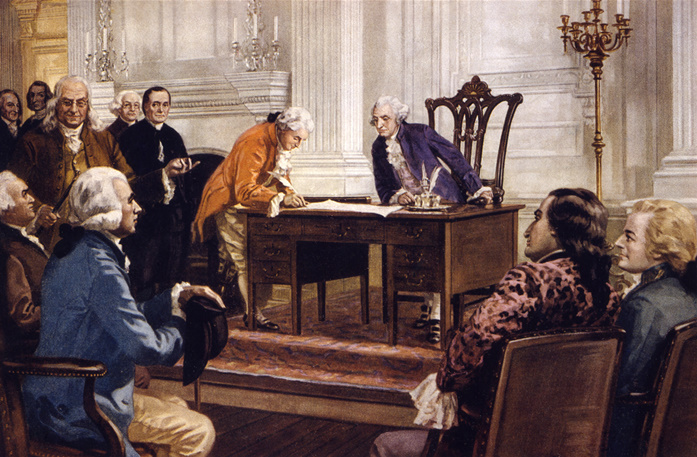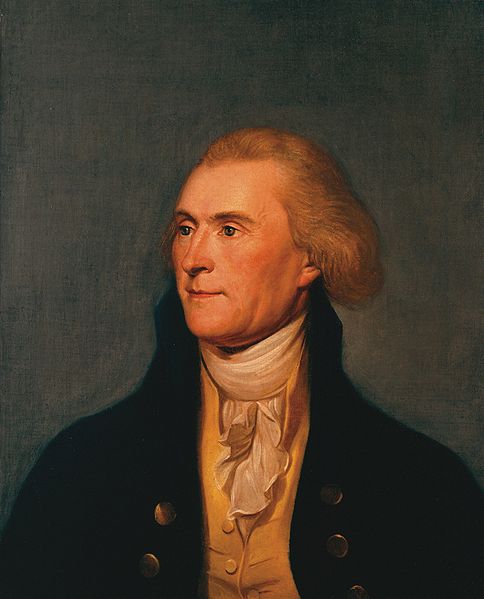At the beginning of the revolutionary process that effected the independence of the thirteen colonies, the majority of the colonists sought neither separation from England nor a change in the form of government. Almost until the end of the process that led to armed revolt, Americans merely claimed rights and liberties considered common to all Englishmen, intending to remain faithful to the British Crown.
For this reason, the majority of the inhabitants did not perceive the issue as one involving a dramatic change from a monarchic colony to an independent republic. In their view, independence was not equivalent to establishing a republican government. “The Americans were not dedicated to overthrowing the King’s authority at the outset,” confirms Maier.(1)

The U.S. Constitution is signed on September 17, 1787 at the Constitutional Convention in Philadelphia. Painting by Henry Hintermeister
Nevertheless, the radicalization of the confrontation in its final phases, as well as the drafting of the Declaration of Independence and the constitutions of the various states, made it quite clear that the conflict had assumed larger objectives; the revolt had transcended guaranteeing liberties that all English subjects should enjoy and had acquired an ideological nature: It had become a republican revolution, “sustained by a powerful, even millennial, creed by which Americans saw themselves no longer merely contending for the protection of particular liberties but on the verge of ushering in a new era of freedom and bliss.”(2)
The concept of a republican form of government was unclear to the American people. Not even those who desired to implant it could formulate the concept in a viable way. “The very word [republic] inspired confusion,” notes Maier, “such that John Adams, perhaps the country’s most learned student of politics, complained that he ‘never understood’ what a republican government was and believed ‘no other man ever did or ever will.’”(3)
Indeed, even after the exodus of politically active Loyalists, monarchist manifestations in many sectors of the population revealed the existence of strong monarchist tendencies, latent or patent, which the republican revolutionaries were obliged to repress energetically, contradicting their own liberal principles.
Not only were these tendencies not extinguished with independence, they remained dynamic throughout the first and crucial period of national life. They showed themselves to be particularly strong in the armed forces of the new nation, the Continental Army. Washington himself commented, notes Myers, “that he had been pressed to assume a crown on more than one occasion.”(4)
During the administration of Washington and Adams, the presidency was permeated with an aura of pomp and ceremony reminiscent of the European royalty. Revolutionary sensibilities particularly bristled when the head of state was transported in an elegant carriage pulled by six white horses with uniformed postillions and footmen. Even more offensive to the ears of Democratic-Republicans was the proposal presented in the Senate to give the president the title of “His Highness, the President of the United States of America.”
“Government was inevitably imbued with the tone of society,” explains Merrill Peterson. “Adams, with many others, thought that some of the pomp and majesty of Old World courts was needed to impress the people with the dignity and authority of the new government. The flavor of a court, albeit a republican one, was everywhere.”(5)
Striking evidence of the pervasiveness of these aristocratic sentiments and monarchical tendencies can be found in the private correspondence of Thomas Jefferson, a Democratic-Republican leader who strongly opposed this attitude. Returning to the American capital in 1790 to assume the position of secretary of state in Washington’s administration, Jefferson described the prevailing monarchist sentiment in the federal government of the time:
“I found a state of things, in the general society of the place, which I could not have supposed possible. Being a stranger there, I was feasted from table to table…. The revolution I had left, and that we had just gone through in the recent change of our government, being the common topics of conversation, I was astonished to find the general prevalence of monarchical sentiments, insomuch that in maintaining those of republicanism I had always the whole company on my hands, never scarcely finding among them a single coadvocate in that argument…. The furthest that any one would go, in support of the republican features of our new government, would be to say, ‘the present Constitution is well as a beginning, and may be allowed a fair trial; but it is, in fact, only a stepping-stone to something better.’”(6)

Portrait of Thomas Jefferson which hangs in the Thomas Jefferson State Reception Room on the 8th floor of the main U.S. Department of State building in Washington, D.C. It was painted by Charles Willson Peale while Jefferson was Secretary of State.
The existence of these monarchist propensities was recognized by Washington himself. Regarding a letter of Washington to Madison on March 31, 1787, Myers observes:
“Having said that monarchy was contrary to the American psyche, Washington then went on to make an astounding observation. ‘I am also clear, that even admitting the utility; nay the necessity of the [monarchic] form, yet that period is not yet arrived for adopting the change without shaking the Peace of this country to its foundation.’ That is, Washington’s objections were to the timing, not the idea of monarchy. The time for monarchy had simply ‘not yet arrived.’”(7)
(1) Pauline Maier, From Resistance to Revolution: Colonial Radicals and the Development of American Opposition to Great Britain, 1765-1776 (New York: Random House, 1972), p. 161.
(2) Gordon S. Wood, The Creation of the American Republic, 1776-1787 (New York: Harper & Row, 1957), p. 44.
(3) Maier, From Resistance to Revolution, p. 287.
(4) Minor Myers, Jr., Liberty without Anarchy: A History of the Society of the Cincinnati (Charlottesville, N.C.: The University Press of Virginia, 1983), p. 84.
(5) Merrill D. Peterson, Thomas Jefferson and The New Nation: A Biography (New York: Oxford University Press, 1970), pp. 405, 406.
(6) Quoted in Arthur Meier Schlesinger, New Viewpoints in American History (New York: Macmillan, 1922), p. 82.
(7) Myers, Liberty Without Anarchy, p. 85.
Plinio Corrêa de Oliveira, Nobility and Analogous Traditional Elites in the Allocutions of Pius XII: A Theme Illuminating American Social History (York, Penn.: The American Society for the Defense of Tradition, Family, and Property, 1993), Appendix I, pp. 274-277.












